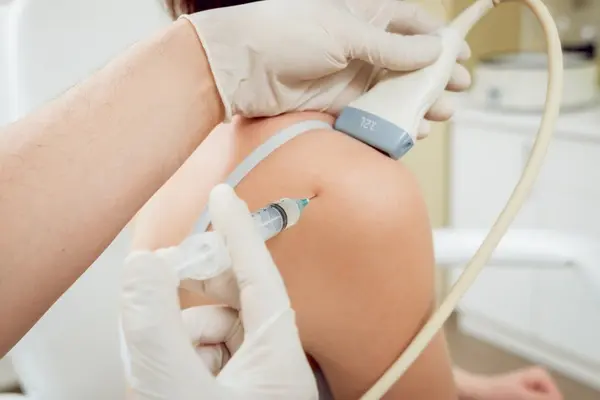If you need an ultrasound-guided injection, you’ll likely have questions over how effective it will be and how long those effects are going to last. In this article, we’ve looked at some of the key aspects of this procedure. We’ve also answered some of the most common questions such as: how long does an ultrasound-guided injection last, what is its success rate, what are the effects, and what happens once you’ve had the injection.

What are ultrasound-guided injections?
Ultrasound-guided injections (USGI) are commonly used to provide pain relief and reduce inflammation in various joints and soft tissue conditions. There are three types of ultrasound-guided injections:
- Ultrasound-guided steroid and/or local anaesthetic injection
- Ultrasound-guided hyaluronic acid injection
- Ultrasound-guided platelet rich plasma injection.
How successful are ultrasound-guided injections?
Ultrasound-guided injections are very successful in delivering targeted pain relief to affected areas. This is due to the increased accuracy from using ultrasound, which allows the consultant to visualise the placement of the needle once it’s inserted.
The clinician administering the injection has the benefit of detailed imaging. This means pain relief can be targeted with a very high degree of accuracy to the affected area. This increases both the effectiveness and longevity of the treatment.
However, USGI is not intended to be a long-term solution to ongoing issues. Your symptoms will likely improve for a few months but other means of treatment are often needed to support ongoing improvements.
What should I expect after an ultrasound-guided injection?
It usually takes 7-10 days before the full effect of the treatment can be felt. The pain should be significantly reduced within a week of the injection.
The initial numbness from the injection will usually wear off within a few hours. If you’ve had a local anaesthetic, you may feel pain relief immediately after the injection.
Ultrasound injections are relatively safe. However, there are still some risks of side effects. These include:
- bleeding
- infection
- numbness
- allergic reaction.
If you’re receiving a joint injection, you’re advised to refrain from vigorous exercise for approximately one week. In the case of a tendon injection, you may be advised to avoid heavy impact activities and strenuous load-bearing for up to 14 days.
Read more on ultrasound guided-injections costs in our guide.
How long will the effects last?
Ultrasound-guided injections usually give you a window of pain relief. This can last for a few months and help you progress with other treatment options like exercise therapy and self-management strategies.
However, the duration of the effects varies depending on the specific condition being treated and individual factors.
How long does an injection last in the knee?
For knee injections, the longevity of the effects can vary depending on the type of medication administered and the severity of your knee condition. Ultrasound-guided injections in the knee are often used to alleviate discomfort and allow for rehabilitation.
For example, you may be able to start physiotherapy 1-2 weeks after the injection to optimise its impact.
Some people may experience long-term pain relief following a steroid injection.
How long does an injection in the hip last?
Similarly, hip injections can provide relief for varying durations depending on the severity and age of your condition. In some instances, a single injection into a joint is enough to alleviate the pain and allow you to begin physiotherapy.
Patients with long term or degenerative conditions are more likely to experience a recurrence of pain. In this case, follow-up injections are likely required. For chronic conditions, repeated injections at regular intervals can play an important part in ongoing pain management. They can also help you to stay fit and active.
What’s the next step if the injection doesn’t work?
It’s well worth remembering that ultrasound-guided injections are not a long-term solution. They help to manage pain, progress with physio exercises, and improve your ability to function. In the event you continue to have pain and reduced function, the next step may involve knee or hip surgery. Surgical interventions, such as joint replacement, can help fix the root cause of severe joint pain. Talk to your doctor or health provider if you’re looking for a better solution to your pain.






